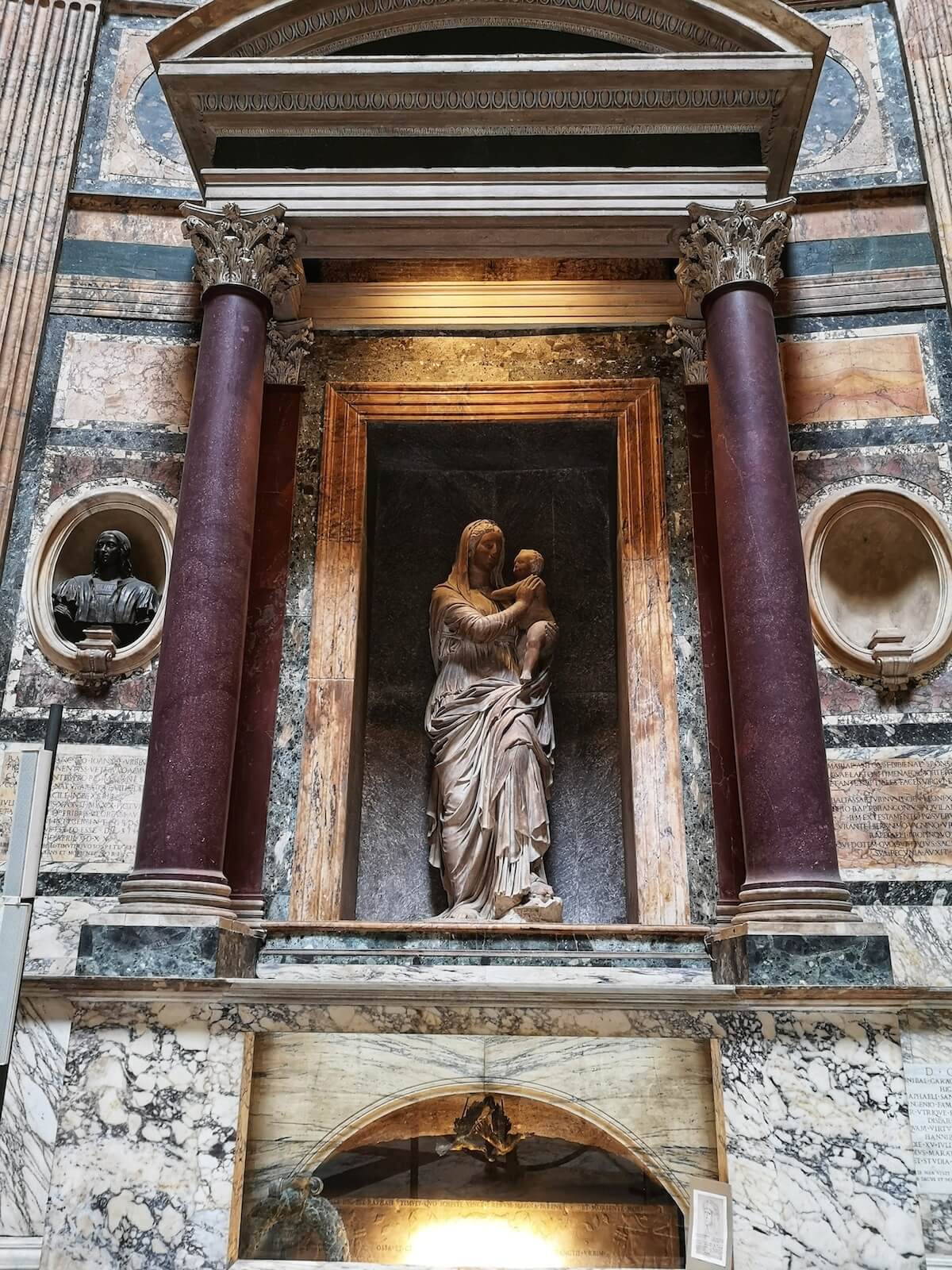The Pantheon, beyond its architectural splendor, serves as the final resting place for some of Italy’s most illustrious historical figures. This dual role as both a marvel of ancient engineering and a hallowed tomb adds layers of historical and cultural significance to the building. Let’s explore the stories of the famous individuals interred within this iconic structure.
Raphael (1483-1520)
The Renaissance Master
Arguably the most famous occupant of the Pantheon, Raphael was a key figure of the Italian High Renaissance, renowned for his paintings and frescoes.
Final Resting Place
Raphael’s tomb is located in the third chapel on the left as you enter the Pantheon. His epitaph, written by Pietro Bembo, reads “Here lies Raphael, by whom Nature feared to be outdone while he lived, and when he died, feared that she herself would die.”
Visiting the Tomb
Look for the sculpture of the Madonna del Sasso (Madonna of the Rock) by Lorenzetto, which adorns Raphael’s tomb.
Vittorio Emanuele II (1820-1878)
The First King of Unified Italy
Vittorio Emanuele II played a crucial role in the unification of Italy and became its first king in 1861.
Royal Tomb
His tomb, located on the right side of the Pantheon, is marked by an imposing bronze statue and is often adorned with flowers and tributes.
Historical Significance
The king’s interment in the Pantheon symbolized the new Italian state’s connection to the glory of ancient Rome.
Umberto I (1844-1900)
Son of Vittorio Emanuele II
The second king of unified Italy, Umberto I, chose to be buried in the Pantheon near his father.
Assassination and Legacy
Umberto I was assassinated in 1900, leading to an outpouring of national mourning.
Location in the Pantheon
His tomb is opposite that of his father, creating a symmetry that reflects their historical roles.
Margherita of Savoy (1851-1926)
Queen Consort of Italy
Wife of Umberto I, Margherita was a popular queen known for her charity work and cultural patronage.
The Queen’s Resting Place
Her tomb is next to her husband’s, completing the royal family group within the Pantheon.
Cultural Impact
The famous Margherita pizza was allegedly named in her honor, showcasing her enduring popularity.
Annibale Carracci (1560-1609)
Baroque Painter and Innovator
Carracci was a significant figure in the transition from Mannerist to Baroque art in Italy.
Artistic Legacy
His work in the Palazzo Farnese in Rome is considered one of the masterpieces of Baroque ceiling fresco.
Tomb Location
Carracci’s tomb is less prominent than some others but is an important stop for art history enthusiasts.
Baldassare Peruzzi (1481-1536)
Renaissance Architect and Painter
Peruzzi was a contemporary of Raphael and worked on St. Peter’s Basilica.
Architectural Influence
His designs influenced the development of the Roman architectural style in the 16th century.
Visiting the Tomb
While less ornate than some, Peruzzi’s tomb is a point of interest for those interested in Renaissance architecture.
Arcadio Huang (1679-1716)
Chinese Christian Convert and Scholar
Huang’s presence in the Pantheon reflects Rome’s role as a cosmopolitan center in the early 18th century.
Cultural Significance
He worked as a librarian in the Vatican and helped bridge Chinese and European cultures.
An Unusual Burial
Huang’s interment in the Pantheon is unique and speaks to the building’s evolving role over time.
Visiting Tips for Tomb Explorers
Guided Tours
Consider joining a guided tour focused on the Pantheon’s tombs for in-depth historical context.
Optimal Timing
Visit early in the morning or late afternoon to avoid crowds and have a more contemplative experience.
Respectful Observation
Remember that the Pantheon is both a historic site and an active church. Maintain a respectful demeanor, especially around the tombs.
The Pantheon’s Evolving Role
From Pagan Temple to Christian Church
The presence of these tombs reflects the Pantheon’s transformation from a Roman temple to a Christian church.
Symbol of Italian Unity
The royal tombs, in particular, underscore the Pantheon’s significance in modern Italian history.
Conservation Efforts
Preserving History
Ongoing efforts are made to preserve both the structure of the Pantheon and the integrity of the tombs within.
Balancing Access and Preservation
Visitors play a role in conservation by following guidelines and treating the site with respect.
Conclusion
The Pantheon’s role as a mausoleum adds a profound layer of historical and cultural significance to this already awe-inspiring structure. As you walk its ancient floors, you’re not just admiring architectural wonders, but also standing among some of the most influential figures in Italian history and culture.
Each tomb tells a story – of artistic genius, political power, cultural exchange, and national identity. These stories intertwine with the Pantheon’s own long history, creating a rich tapestry that connects ancient Rome to the present day.
As you plan your visit, consider the lives and legacies of these famous occupants. Their presence transforms the Pantheon from a purely architectural marvel into a bridge across time, where the achievements of the past continue to inspire the present. In honoring these historic figures, we also celebrate the enduring spirit of human creativity, leadership, and cultural exchange that the Pantheon has witnessed over its long and storied existence.






